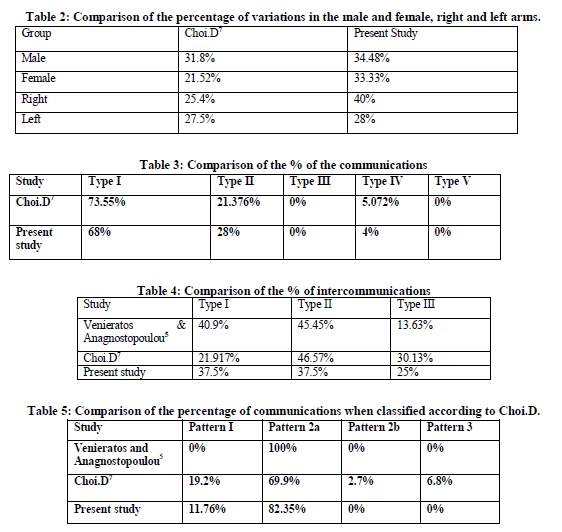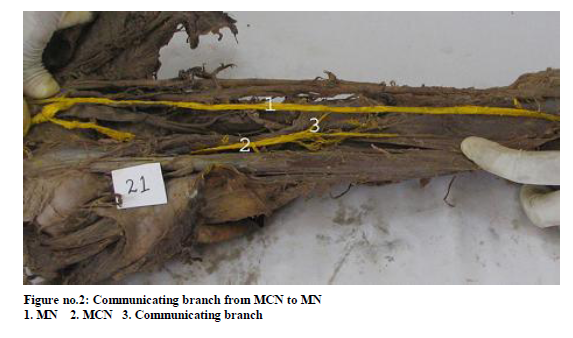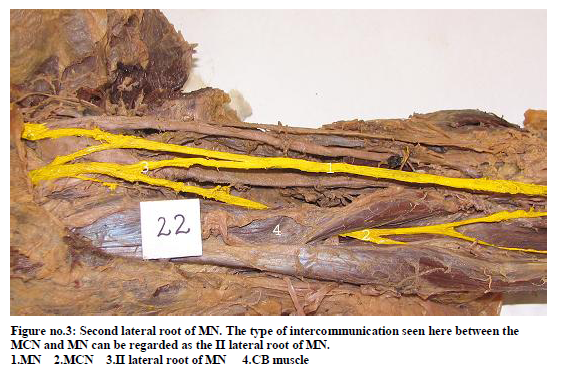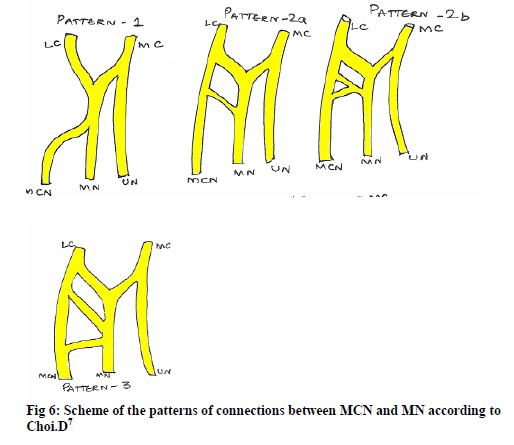IJCRR - 5(8), April, 2013
Pages: 32-40
Date of Publication: 25-Apr-2013
Print Article
Download XML Download PDF
COMMUNICATIONS BETWEEN MUSCULOCUTANEOUS NERVE AND MEDIAN NERVE - A STUDY
Author: Akhilandeswari Balasubramanian, Shubha Rajanna
Category: Healthcare
Abstract:study was done to note the communications between the Musculocutaneous nerve and Median nerve. Of the 50 arms studied, 17 had variations. Communications from the Musculocutaneous nerve to the Median nerve were seen in 76.47% of the variant arms. Of these, 53.8% were in the upper 1/3 of the arm, 38.46% in the middle 1/3 and 7.69% in the distal 1/3 of the arm. A communicating branch from the Median nerve to the Musculocutaneous nerve was found only in 5.88% of the variant arms. In 11.76% of the variant arms, the whole lateral cord joined the medial root to form the Median nerve. The Musculocutaneous nerve then arose from the Median nerve. When the communications were classified according to the classification by earlier authors [Venieratos D, Anagnostopoulou S 1998, Choi. D 2002] the percentage of the communicating branches agreed with those of the earlier studies. The results of this study show that the intercommunications between Musculocutaneous nerve and Median nerve are frequent. These variations are frequent and have to be studied in detail by every surgeon so as to prevent any iatrogenic damage during surgery. These intercommunications can result in neuropathies with atypical presentation. Incorrect diagnosis and unnecessary surgeries (e.g, carpal tunnel release) can be avoided if the surgeon keeps in mind these variations and the clinical presentation of these variant nerves in case of an injury.
Keywords: Communications, Musculocutaneous nerve, Median nerve, Variations.
Full Text:
INTRODUCTION
Musculocutaneous nerve of the arm innervates the flexor muscles of the arm and then continues as the lateral cutaneous nerve of the forearm. Anatomic variations of the peripheral nervous system often form the basis of unexpected clinical signs and symptoms.
Normal and anomalous position of the arteries and veins may be determined pre-operatively by angiographic studies, but in case of nerves it is not possible to detect such an anomaly1.Good knowledge of variations of the musculocutaneous nerve and its possible communications with median nerve is valuable in the traumatology of the shoulder joint, exploratory procedures and in repair operations. Hence this study will be of considerable value and of service in diagnosis and treatment in the neurosurgical department.
MATERIALS AND METHODS
The musculocutaneous nerve was studied in 50 embalmed human cadaver upperlimbs. The sample included 29 male and 21 female upperlimbs obtained from the Anatomy departments of Medical colleges in Bangalore,India.
Upperlimb dissection was done by following the guidelines of Cunninghams manual2. The musculocutaneous nerve entering the deep surface of coracobrachialis was identified and followed upwards to its origin from the brachial plexus. Intercommunications between musculocutaneous nerve and median nerve were looked for and noted down.
RESULTS
The percentage of variations seen in male was 34.48% and that of female 33.33%.
The right arm (40% ) recorded more percentage of variations than that of left arm (28%). Most of the variations noted were of intercommunications between MCN and MN. Communications between MCN and any other nerve except median nerve was not found in this study.
Communication between musculocutaneous nerve and median nerve
Communication between musculocutaneous nerve and median nerve was noted in 16/50 arms studied (32%). The intercommunications were classified into 5 types according to Le Minor3 .
DISCUSSION
The results obtained were compared with similar data from previous studies.
Communication between musculocutaneous nerve and median nerve
Variations involving communication between the musculocutaneous and median nerves were the commonest recorded in earlier studies4. The most frequent was the communicating branch that arose from the MCN and ran distally to join the MN 5.
The communications between the MCN and MN was considered as a remnant from the phylogenetic point of view6. Existence of such connections were seen in some monkeys and some apes. In man, this could represent the primitive MN supply of the anterior arm muscles7.
The following table compares the percentage of intercommunications seen in the present study with that of earlier studies.
Table-1
The percentage of intercommunications seen in the present study is more when compared to that of earlier studies. This may be due to some authors considering cases of MCN arising from MN as absence of MCN whereas in the present study, it was included under intercommunication between the two nerves.
Figure-1
Percentage of variations in male/female and right/left arms.
Percentage of variations in male/female and right /left arms seen in the present study is compared with an earlier study7 and tabulated below.
Table-2
When compared to that of the earlier study, the present study shows a higher percentage of variations in the female and in the right arms. This difference may be attributed to a difference in the sample size and a difference in the race of the population studied.
Communicating branch from the MCN to the MN
Figure-2
In the present study, the communicating branch originated in the upper 1/3 of the arm in 53.8% of cases. The communicating branch arising in the upper 1/3 of the arm, before the MCN pierced the CB muscle is also regarded as the II lateral root of MN.
Figure-3
The communicating branch arose from the MCN in the middle 1/3 of the arm in 38.46% (5/13) and in the distal 1/3 of the arm in 7.69% cases (1/13).
Communicating branch from MN to MCN
A communicating branch from the MN to MCN was reported to be uncommon .
In the present study, a communicating branch from the MN to MCN was seen only in 5.88% (1/17) of the variant arms.
This type of intercommunication can be due to the nerve fibres from the C5 and C6 ventral rami hitch hiking along the MN and rejoining the MCN in the lower 1/2 of the arm. This may be the effect of “neurobiotaxis” occurring during fetal development 13.
Fusion of MCN and MN
In some cases, the whole Lateral cord along with the fibres destined for MCN joined the medial root of MN to from the trunk of the MN and the muscular branches which were usually given off from the MCN arose from the MN individually or as a common trunk. This was considered by some authors as absence of MCN14, 15 while others considered it as fusion of MCN & MN7. Here the common trunk which arose from the fused MN trunk was considered as MCN arising from the MN. This was seen in 11.76% i.e, 2/17 of the variant arms. The MCN may join the MN in the lower 1/3 of arm to form an ansa 8% 4. Apart from these cases, in 1 case, the whole MCN joined the MN in the distal 1/3 of the arm after giving branches to all the 3 muscles.
Two or more communications between MCN and MN
Presence of many communicating branches was also called as plexiform pattern 7.
In the present study, in one of the cases where the MCN arose from the MN, a communicating branch arose from the MN and joined the MCN. This was the only case where two communications between the MCN and the MN was found.
Classification of communications between MCN and MN
The communications that were discussed above were classified according to different authors and compared with earlier studies.
Le Minor’s classification
Figure-4
The variations of the musculocutaneous and median nerve were classified into five types by Le Minor3.
The following table compares the communicating branches classified according to Le Minor’s classification in the present study with an earlier study.
Table-3
The percentage of intercommunications in the present study coincides with that seen in the earlier study.
Venieratos and Anagnostopoulou’s classification
The communications were classified into 3 types according to the site of occurance of the communication with respect to the CB muscle5.
Figure-5
The percentage of communicating branches between MCN and MN in the present study is classified and compared with the earlier studies in the following table .
Table-4
On comparison, the % of the intercommunications in the present coincided with that of earlier studies 5, 7 .
Choi.D’s classification
This unified classification included their own results and those of the others and consisted of 3 patterns7.
Figure-6
The results of this study were classified according to Choi.D’s and compared to that of earlier studies in the table given below.
Table-5
The results in the present study coincided with that of Choi.D. After considering the 3 types of classification given above, it is concluded that the classification by Choi.D is complete, and as it included all the possible types of communications.
Clinical implications of the various communications
In case of communication between the MCN and MN, some fibres of MN usually run in the MCN leaving it to join the proper trunk later. In such cases, a combined lesion of MCN and part of the MN would occur in injury to the MCN. Lesions of the connecting nerve may impose difficulty in diagnosis. Injury to the MCN, proximal to the anastomotic branch between MCN and MN may lead to unexpected presentation of weakness of forearm flexors and thenar muscles. Knowledge of various communications is important in the evaluation of unexplained sensory loss after trauma or surgical intervention in a particular area13.
Anterior surgical approach to the shoulder joint may be complicated by the presence of communicating branches. In case of presence of a II lateral root of MN, after a trauma to the arm, signs of MN injury could be observed in a patient with an intact MN, if the fibres coursing in the MCN are damaged. Result of exploratory intervention of the arm for peripheral nerve repair in a patient with these variations can be successful, only if the surgeon is aware of such variations of peripheral nerves and specifically looks for their presence.
During flap dissections, unexpected nerve damages could be caused especially by surgeons who are inexperienced in variations. Any injury to the MCN in a patient with this kind of variation presents as double nerve injury which makes the diagnosis problematic. Although anterior approach for internal fixation of humeral fracture seems to be safer than the posterior approach because of high risk of radial nerve damage in the latter, neurovascular variations should be kept in mind to prevent iatrogenic damage to these structures during their retraction for exposure of the fracture line16.
CONCLUSION
The results of the study discussed, clearly show that the Musculocutaneous nerve shows frequent variations. Most of the variations are intercommunications between Musculocutaneous nerve and Median nerve. Communications between the MCN and MN were recorded in 32% of the cases. The variant arms were more of the right side but no gender difference was seen. When the communications are classified according to the classification by earlier authors (Choi.D et al 2002, Venieratos.D, Anagnostopoulou.S 1998), the percentage of the communicating branches agree with those of the earlier studies.
The presence of variations thus appears to be an almost normal entity of Musculocutaneous nerve. These variations are frequent and have to be studied in detail by every surgeon so as to prevent any iatrogenic damage during surgery. These intercommunications can result in neuropathies with atypical presentation. Incorrect diagnosis and unnecessary surgeries (e.g, carpal tunnel release) can be avoided if the surgeon keeps in mind these variations and the clinical presentation of these variant nerves in case of an injury.
Abbreviations Used
MN-Median nerve
MCN-Musculocutaneous nerve
CB-Coracobrachialis
ACKNOWLEDGEMENTS
Authors acknowledge the great help received from the scholars whose articles are cited and included in references of this manuscript. The authors are also grateful to authors / editors / publishers of all those articles, journals and books from where the literature for this article has been reviewed and discussed. Authors are grateful to IJCRR editorial board members and IJCRR team of reviewers who have helped to bring quality to this manuscript.









References:
- Das,S. Paul,S. Anomalous branching pattern of the lateral cord of brachial plexus. Int.J.Morphol 2005; 23(4):289-292.
- Romanes .G.J, The arm. Cunningham’s manual of Practical Anatomy Volume 1:upper limbs and lower limbs, 15th Edition. Oxford University Press, Oxford ,1986:67-68
- Gumusburun E, Adiguzel E. A variation of the brachial plexus characterized by the absence of the MCN; a case report. Surg Radiol Anat 2000; 22: 63-65.
- Bergman R.A, Thompson S.A, Afifi A.K, Saadeh F.A.Compendium of Human Anatomic Variation. Munich: Urban and Schwarzenberg; 1988.
- Venieratos D, Anagnostopoulou S. Classification of communications between the musculocutaneous and median nerves. Clin Anat 1998;11:327-331.
- Chauhan.R and Roy.T.S. Communication between the median and musculocutaneous nerves a case report. J.Anat.Soc.India 2002; 52(1): 72-75.
- Choi D, Rodriguez- Niedenfuhr.M, Vazquez.T, Parkin.I, Sanudo.J.R. Patterns of connections between the musculocutaneous and median nerves in the axilla and arm. Clin Anat 2002; 15:11-17.
- Kerr A.T. The brachial plexus of nerves in man, the variations in its formation and branches. Am J Anat 1918;23:285-395.
- Yang Z, Pho R.W.H, Kour A, Pereira B.P. The musculocutaneous nerve and its branches to the biceps and brachialis muscles. J Hand Surg 1995; 20A: 671-675.
- Chiarapattanakom P, Leechavengvong S, Witoon chart K, Verpairoj kit C, Thurasethakul P. Anatomy and internal topography of the musculocutaneous nerve: the nerves to the biceps and brachialis muscle. J Hand Surg 1998; 23A: 250-255.
- Aktan.Z.A. A cadaveric study of the anatomic variations of the brachial plexus nerves in the axillar region and arm. Turk J Med Sci 2001; 31:147-150.
- Fazan V.P.S, Amadeu A.S, Caleffi A.L, Filho O.A.R. Brachial plexus variations in its formation and main branches. Acta Cir. Bras 2003; Vol.18 Suppl.5 SaoPaulo.
- Saeed.M, Rufai,A.A. Median and musculocutaneous nerves : variant formation and distribution. Clin.Anat 2003; 16(5): 453-457.
- Sud .M, Sharma .A. Absence of musculocutaneous nerve and the innervation of coracobrachialis, biceps brachii and brachialis from the median nerve. J.Anat .Soc .India 2000; 49(2):176-177.
- Rao P.V.V.P, Chaudhary S.C. Absence of musculocutaneous nerve: two case reports. Clin Anat 2001; 14: 31-35.
- Ibrahim.C.H, Adnan.E., Cem.D.C. Variations between median and musculocutaneous nerves Internet.J.Surg 2005; 6(1).
|






 This work is licensed under a Creative Commons Attribution-NonCommercial 4.0 International License
This work is licensed under a Creative Commons Attribution-NonCommercial 4.0 International License